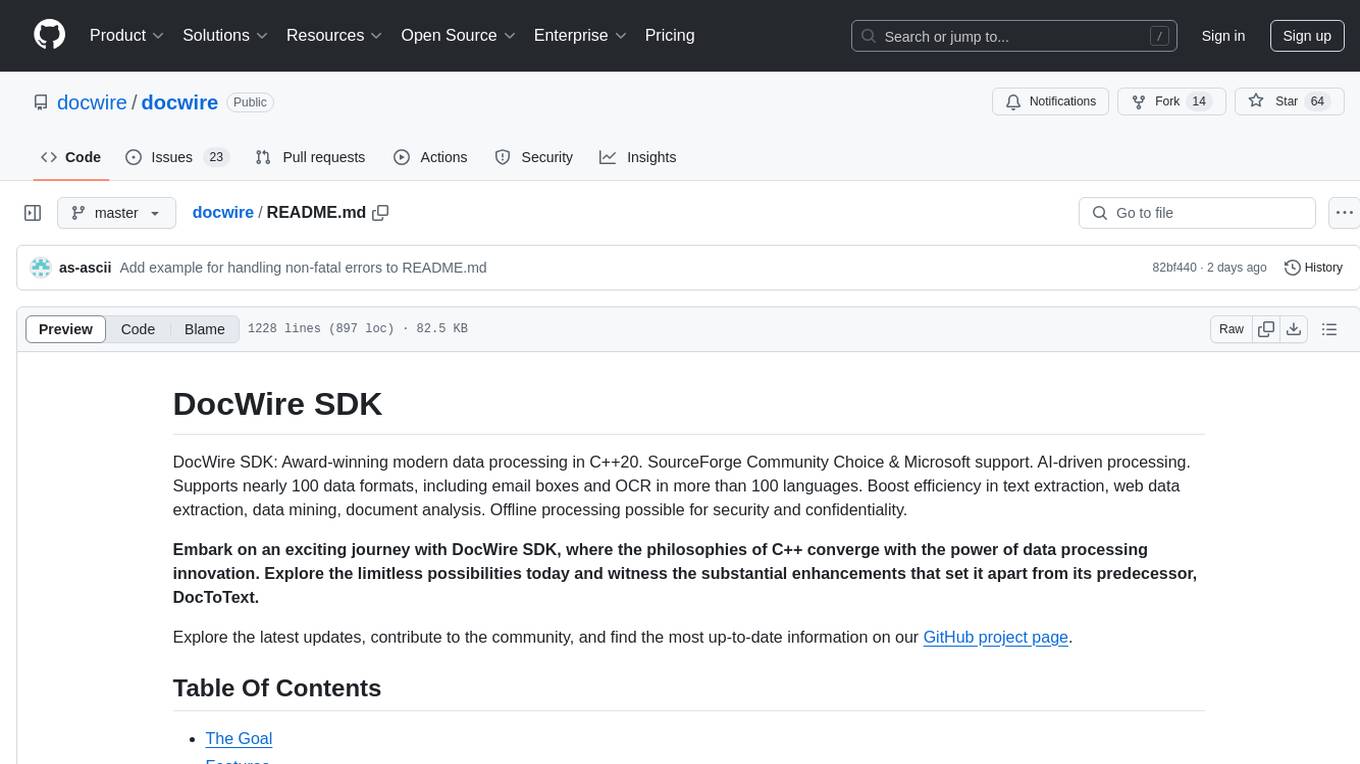
DNAnalyzer
Revolutionizing DNA analysis and making it accessible to all through innovative AI-powered analysis and interpretive tools.
Stars: 129
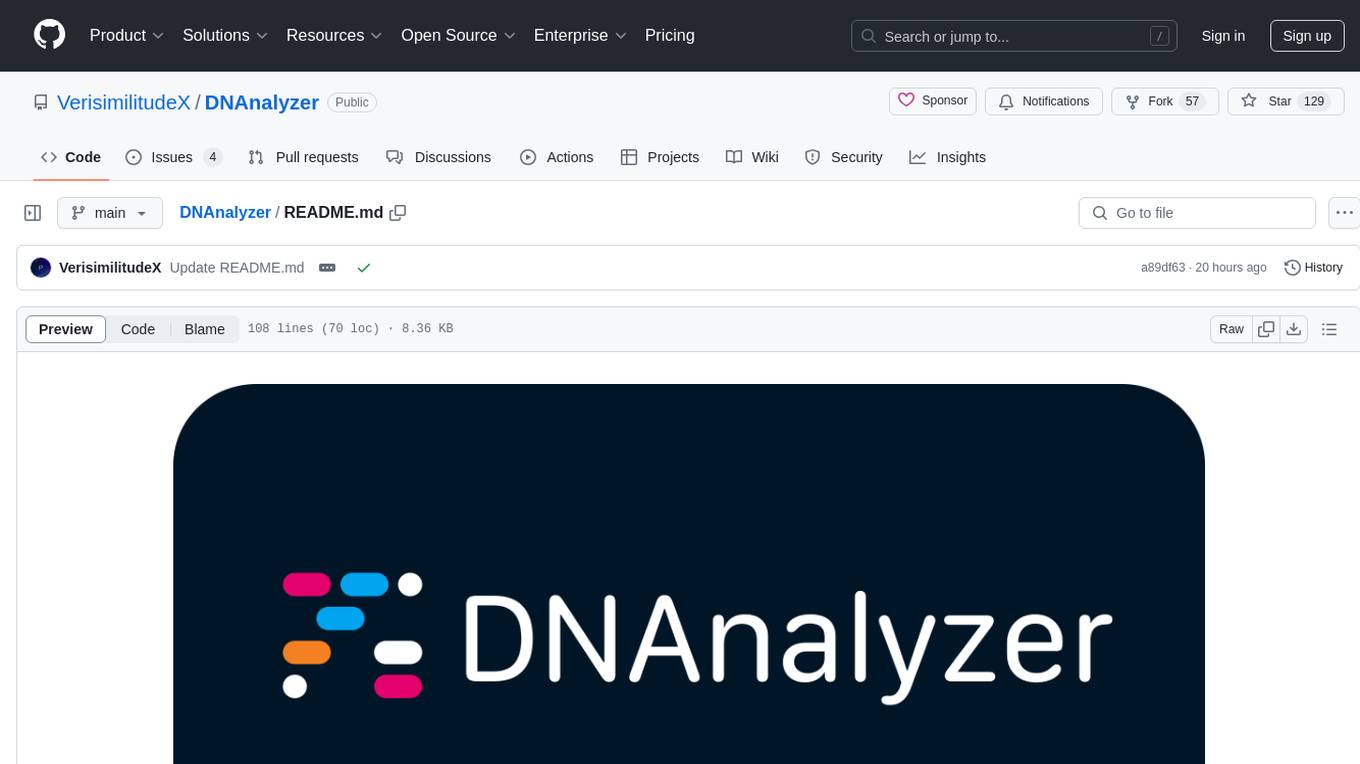
DNAnalyzer is a nonprofit organization dedicated to revolutionizing DNA analysis through AI-powered tools. It aims to democratize access to DNA analysis for a deeper understanding of human health and disease. The tool provides innovative AI-powered analysis and interpretive tools to empower geneticists, physicians, and researchers to gain deep insights into DNA sequences, revolutionizing how we understand human health and disease.
README:
Revolutionizing DNA analysis and making it accessible to all through innovative AI-powered analysis and interpretive tools.
DNAnalyzer is a fiscally sponsored 501(c)(3) nonprofit organization (EIN: 81-2908499) dedicated to revolutionizing the field of DNA analysis. We aim to democratize access to DNA analysis tools for a deeper understanding of human health and disease and pushing the boundaries of what is possible in the field of genetics research to make a significant impact in the industry. It was created by Piyush Acharya and is currently led by him and @LimesKey.
DNAnalyzer is your gateway to deciphering the secrets of DNA. Our innovative AI-powered analysis and interpretive tools empower geneticists, physicians, and researchers to gain deep insights into DNA sequences, revolutionizing how we understand human health and disease.
The human genome is composed of over 3 billion base pairs, making human analysis nearly impossible. Consequently, using powerful computational and statistical methods to decode the functional information hidden in DNA sequences are necessary. The genome is also extremely intricate and contains a plethora of data, which need to be organized and converted into analyzable data appropriately. Current analytical tools and software make it arduous for both geneticists and physicians to do so, thus restricting them from acquiring crucial information to better understand humans. [1]
-
Start and Stop Codons
- Indicate the start and stop of a protein. There are 20 different amino acids. A protein consists of one or more chains of amino acids (called polypeptides) whose sequence is encoded in a gene.
[2]
- Indicate the start and stop of a protein. There are 20 different amino acids. A protein consists of one or more chains of amino acids (called polypeptides) whose sequence is encoded in a gene.
-
High Coverage Regions
- Promoter sequences in the genome that code for proteins have a relatively high proportion of guanine and cytosine nucleotides to the 4 nucleotide bases (45-60% GC-content). Such CpG islands are likely to reveal important information about the genome.
[3]
- Promoter sequences in the genome that code for proteins have a relatively high proportion of guanine and cytosine nucleotides to the 4 nucleotide bases (45-60% GC-content). Such CpG islands are likely to reveal important information about the genome.
-
Neurodevelopmental Disorders
- A group of disorders, usually characterized by longer genes, that affect the development of the brain and nervous
system. These disorders are caused by genetic mutations that affect the development of the
brain and nervous system. These disorders include autism, attention deficit hyperactivity
disorder (ADHD), and schizophrenia.
[4]
- A group of disorders, usually characterized by longer genes, that affect the development of the brain and nervous
system. These disorders are caused by genetic mutations that affect the development of the
brain and nervous system. These disorders include autism, attention deficit hyperactivity
disorder (ADHD), and schizophrenia.
-
Core Promoter Elements
- Promoter sequences are short DNA sequences that are located upstream of a gene and are responsible for initiating transcription (e.g. BRE, TATA, INR, and DPE).
[5]
- Promoter sequences are short DNA sequences that are located upstream of a gene and are responsible for initiating transcription (e.g. BRE, TATA, INR, and DPE).
-
FASTA File Support
- Supports multi-line and single-line FASTA database files. Files can either be uploaded or linked to from the web.
[7]
- Supports multi-line and single-line FASTA database files. Files can either be uploaded or linked to from the web.
-
Command-Line Interface (CLI)
- The Methionine command-line interface (abbreviated as Met CLI) is a unified tool for running DNAnalyzer services from the command-line. The CLI is a powerful tool for using DNAnalyzer services and scripting a sequence of commands to execute. You can currently access all the core features present in DNAnalyzer without having to log in, although account support will be implemented soon. To get more information on Met CLI installation and currently supported commands, refer to Met CLI GitHub repository.
- Web UI Coming Soon
DNA, present in most cells of the body, holds the blueprint for creating over 200 distinct cell types. Like a programming language, it is exclusive to living organisms. With the aid of ML, we can decode and comprehend DNA, leading to life-saving discoveries and valuable insights.
A DNA database is crucial for interpreting DNA sequences. By leveraging machine learning, predictions can be made on previously unseen DNA sequences. This is the foundation on which modern DNA analysis programs operate.
Please refer to the Getting Started document for more information on how to use DNAnalyzer.
Our goal is to find the best SQL database fork that can handle high performance and vertical scaling. We will store and query genomic data from thousands of species, including their genes and mutations. This will help us train our machine learning model more effectively.
This will bring the ability to use genotyped data from 3rd-party DNA testing services with our algorithm. In the future, to use this program, all you will need is a simple $99 DNA Test to be able to experience all the features of DNAnalyzer.
This will combine DIAMOND's performance advantage along with BLAST's algorithm.
View our in-line citations in the Citations document.
Your complete responsibility lies in the utilization of this application, encompassing all actions and consequences that arise. While the DNAnalyzer Team is dedicated to addressing significant issues that may arise, whether reported by users or as new research unfolds, they cannot be held accountable for any losses users may experience due to the application's use, irrespective of circumstances. For further inquiries, please reach out to the following email address: [email protected].
If you use this software in your research, we request that you provide the appropriate citation.
Copyright © Piyush Acharya 2024. DNAnalyzer is a fiscally sponsored 501(c)(3) nonprofit (EIN: 81-2908499). Licensed under the MIT License.
For Tasks:
Click tags to check more tools for each tasksFor Jobs:
Alternative AI tools for DNAnalyzer
Similar Open Source Tools

DNAnalyzer
DNAnalyzer is a nonprofit organization dedicated to revolutionizing DNA analysis through AI-powered tools. It aims to democratize access to DNA analysis for a deeper understanding of human health and disease. The tool provides innovative AI-powered analysis and interpretive tools to empower geneticists, physicians, and researchers to gain deep insights into DNA sequences, revolutionizing how we understand human health and disease.
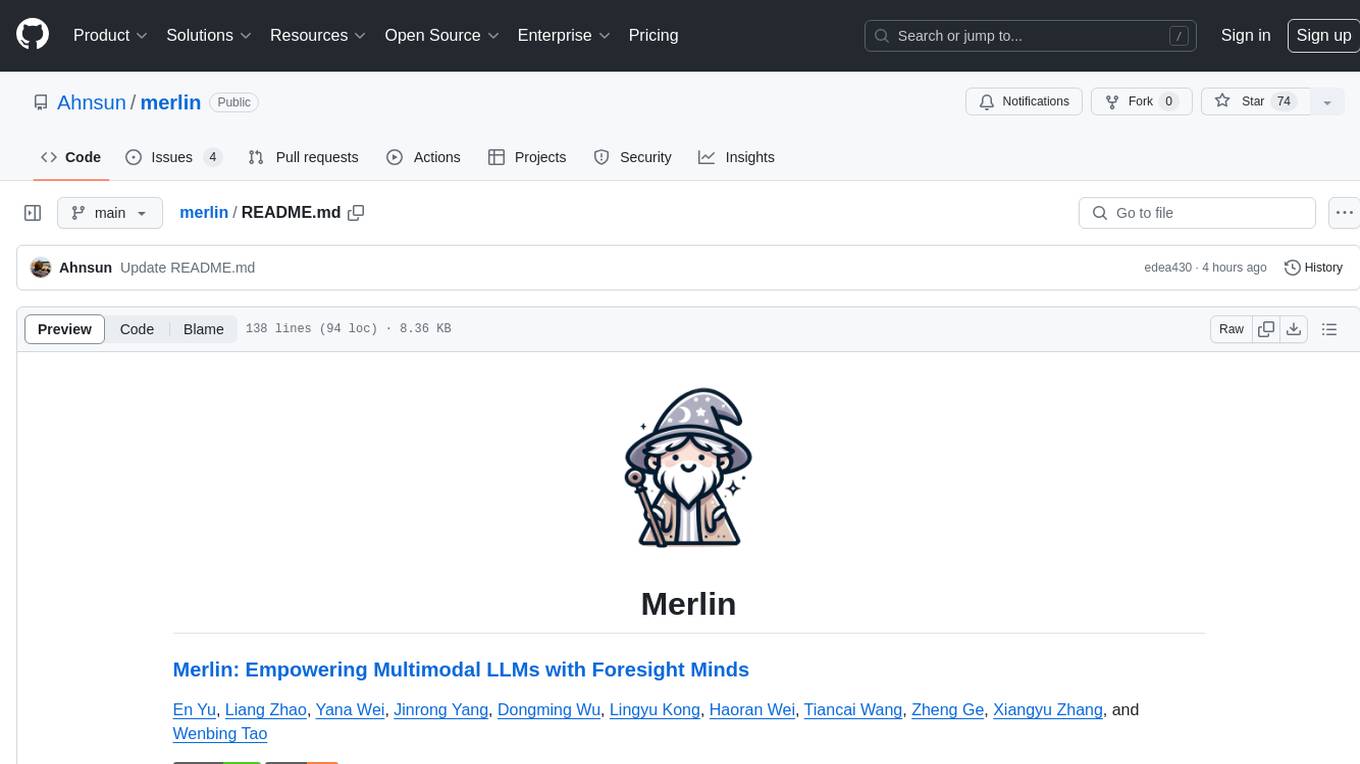
merlin
Merlin is a groundbreaking model capable of generating natural language responses intricately linked with object trajectories of multiple images. It excels in predicting and reasoning about future events based on initial observations, showcasing unprecedented capability in future prediction and reasoning. Merlin achieves state-of-the-art performance on the Future Reasoning Benchmark and multiple existing multimodal language models benchmarks, demonstrating powerful multi-modal general ability and foresight minds.
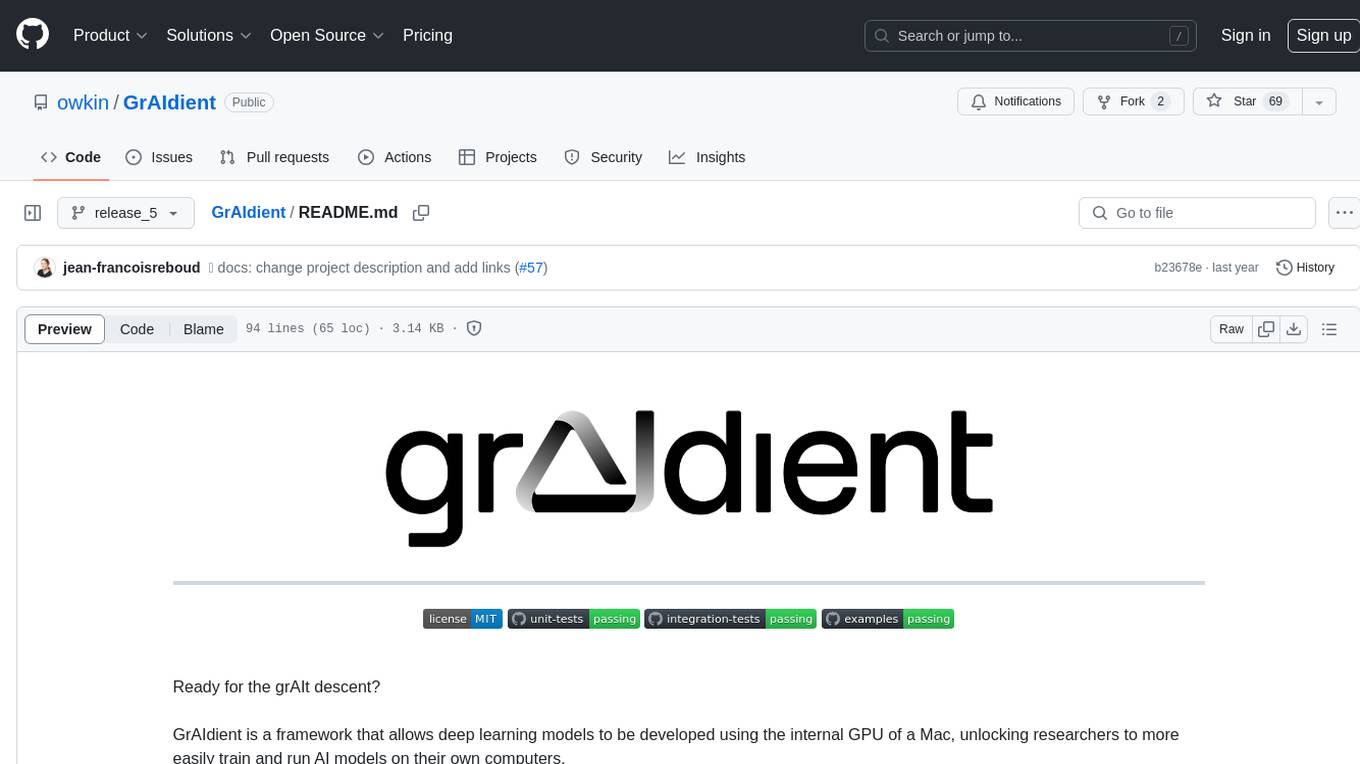
GrAIdient
GrAIdient is a framework designed to enable the development of deep learning models using the internal GPU of a Mac. It provides access to the graph of layers, allowing for unique model design with greater understanding, control, and reproducibility. The goal is to challenge the understanding of deep learning models, transitioning from black box to white box models. Key features include direct access to layers, native Mac GPU support, Swift language implementation, gradient checking, PyTorch interoperability, and more. The documentation covers main concepts, architecture, and examples. GrAIdient is MIT licensed.
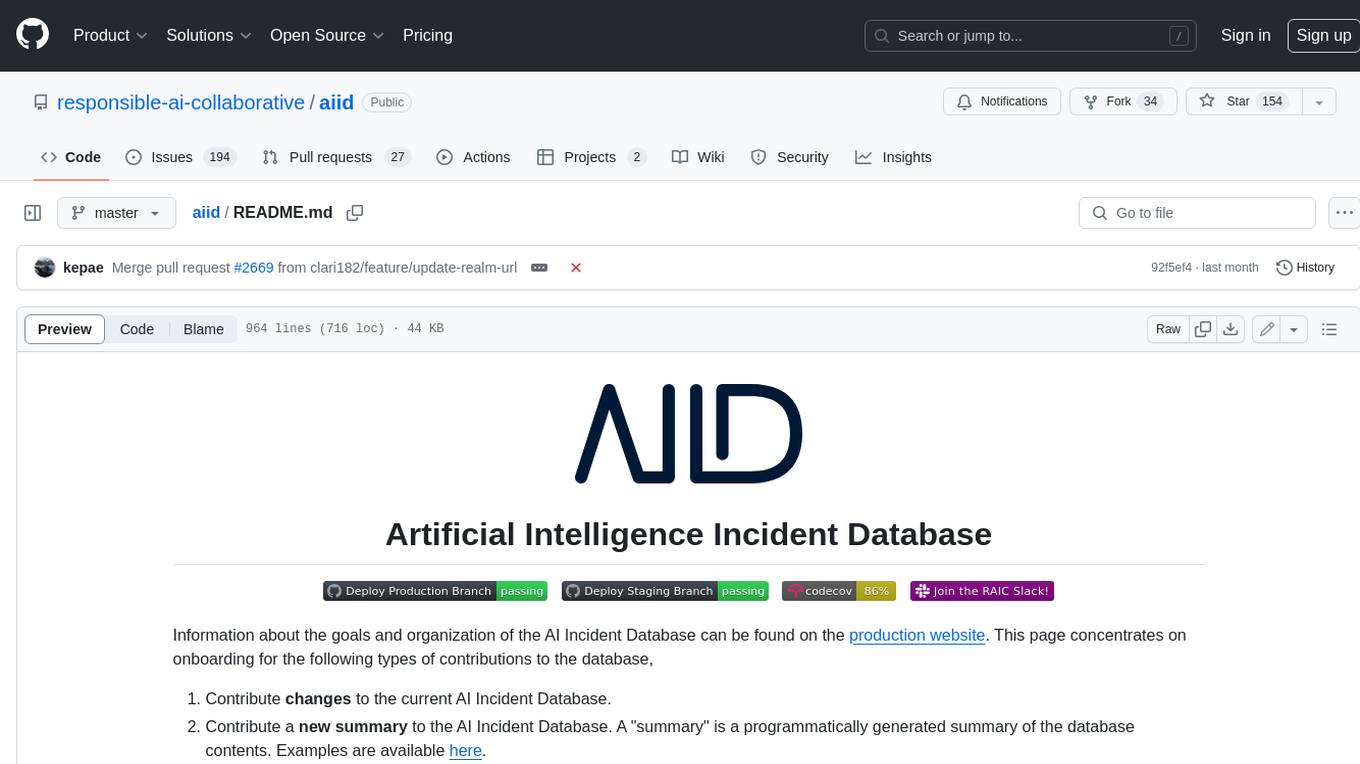
aiid
The Artificial Intelligence Incident Database (AIID) is a collection of incidents involving the development and use of artificial intelligence (AI). The database is designed to help researchers, policymakers, and the public understand the potential risks and benefits of AI, and to inform the development of policies and practices to mitigate the risks and promote the benefits of AI. The AIID is a collaborative project involving researchers from the University of California, Berkeley, the University of Washington, and the University of Toronto.
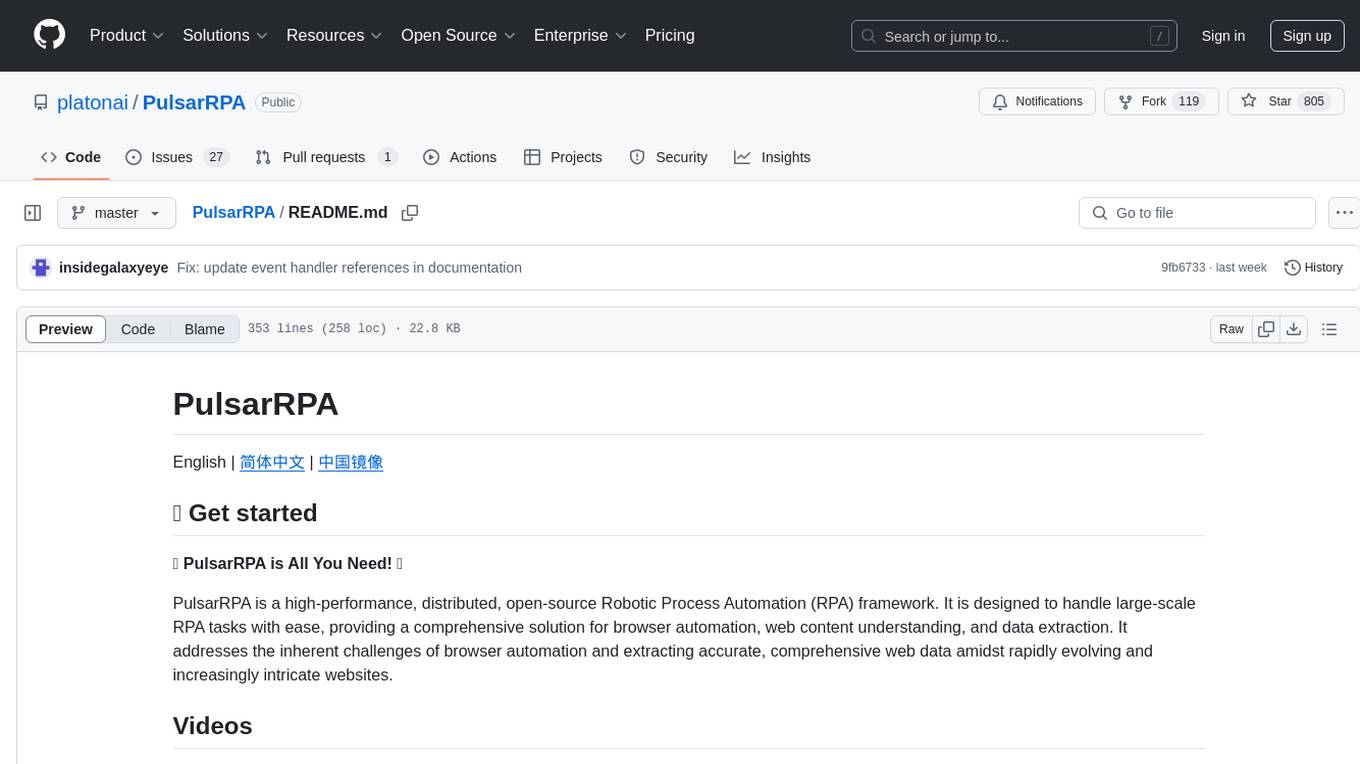
PulsarRPA
PulsarRPA is a high-performance, distributed, open-source Robotic Process Automation (RPA) framework designed to handle large-scale RPA tasks with ease. It provides a comprehensive solution for browser automation, web content understanding, and data extraction. PulsarRPA addresses challenges of browser automation and accurate web data extraction from complex and evolving websites. It incorporates innovative technologies like browser rendering, RPA, intelligent scraping, advanced DOM parsing, and distributed architecture to ensure efficient, accurate, and scalable web data extraction. The tool is open-source, customizable, and supports cutting-edge information extraction technology, making it a preferred solution for large-scale web data extraction.
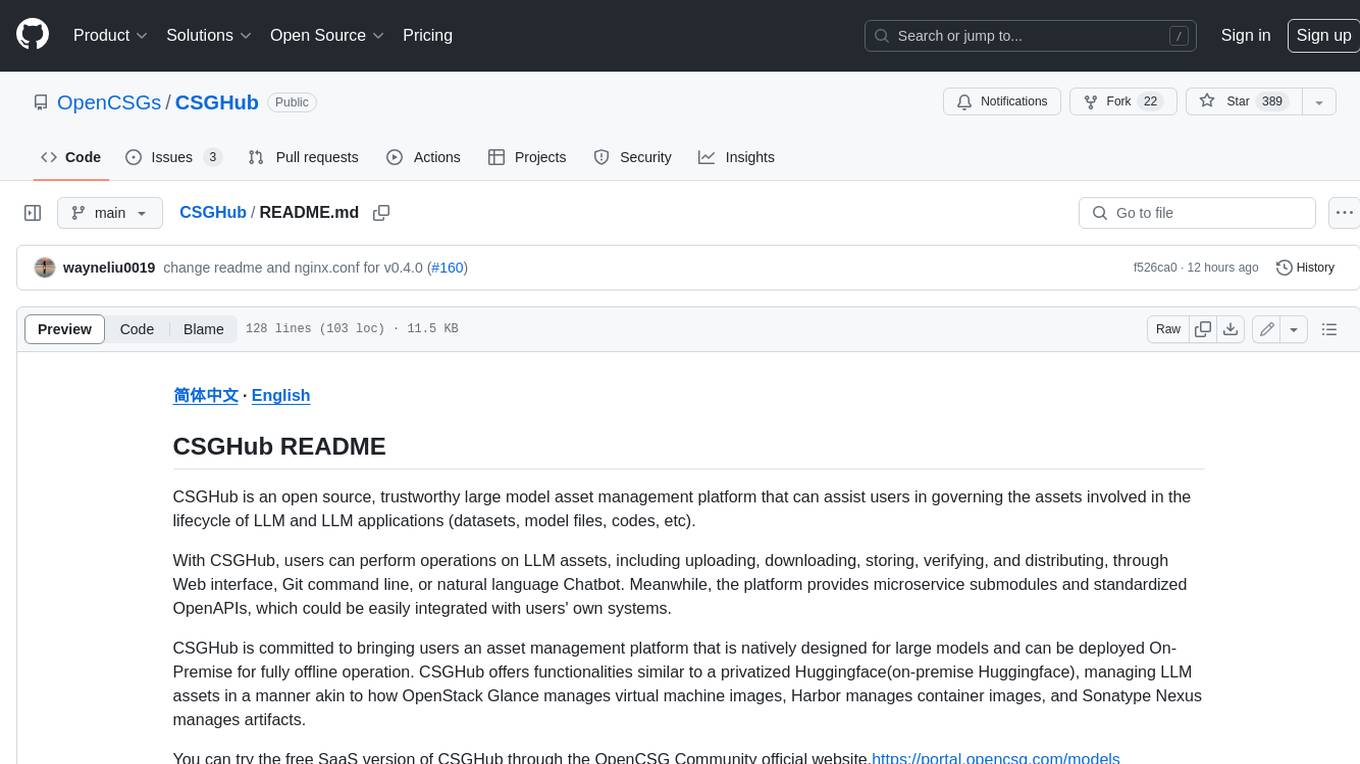
CSGHub
CSGHub is an open source, trustworthy large model asset management platform that can assist users in governing the assets involved in the lifecycle of LLM and LLM applications (datasets, model files, codes, etc). With CSGHub, users can perform operations on LLM assets, including uploading, downloading, storing, verifying, and distributing, through Web interface, Git command line, or natural language Chatbot. Meanwhile, the platform provides microservice submodules and standardized OpenAPIs, which could be easily integrated with users' own systems. CSGHub is committed to bringing users an asset management platform that is natively designed for large models and can be deployed On-Premise for fully offline operation. CSGHub offers functionalities similar to a privatized Huggingface(on-premise Huggingface), managing LLM assets in a manner akin to how OpenStack Glance manages virtual machine images, Harbor manages container images, and Sonatype Nexus manages artifacts.
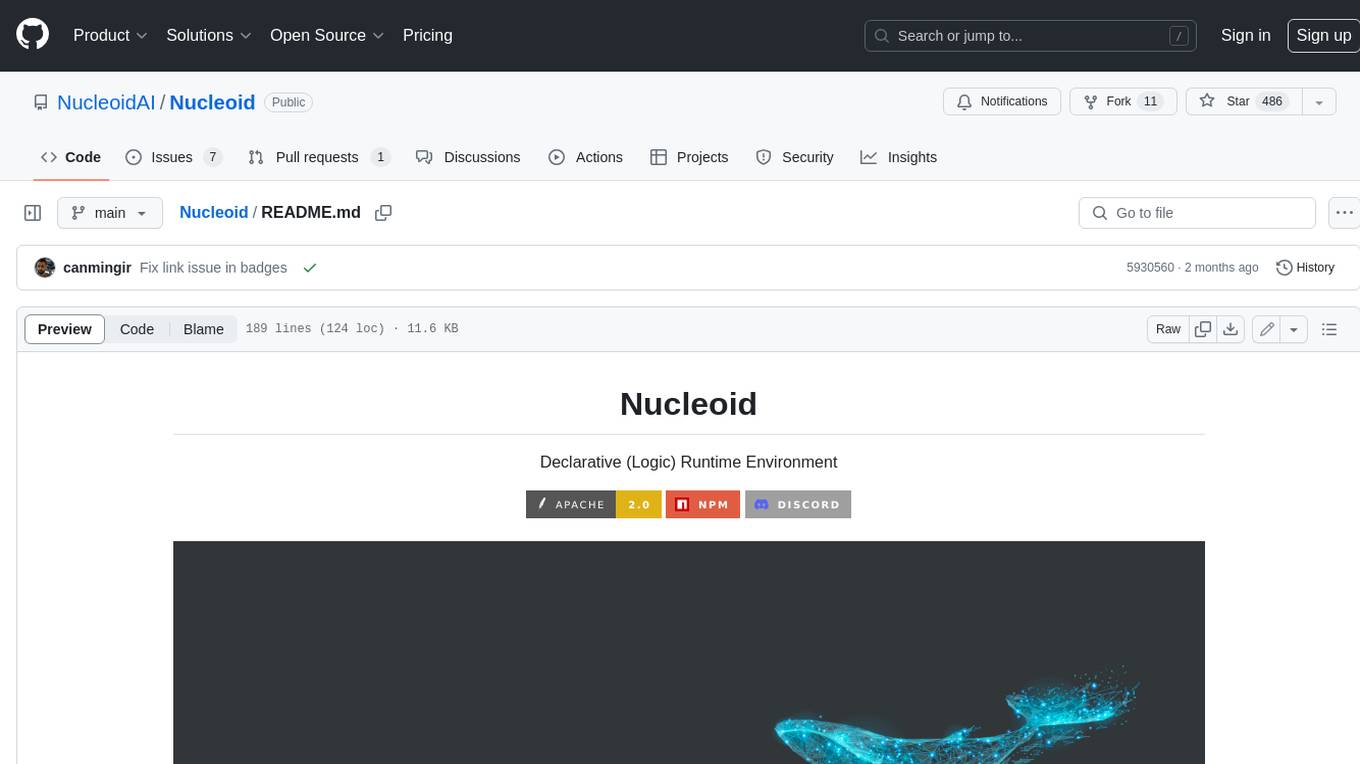
Nucleoid
Nucleoid is a declarative (logic) runtime environment that manages both data and logic under the same runtime. It uses a declarative programming paradigm, which allows developers to focus on the business logic of the application, while the runtime manages the technical details. This allows for faster development and reduces the amount of code that needs to be written. Additionally, the sharding feature can help to distribute the load across multiple instances, which can further improve the performance of the system.
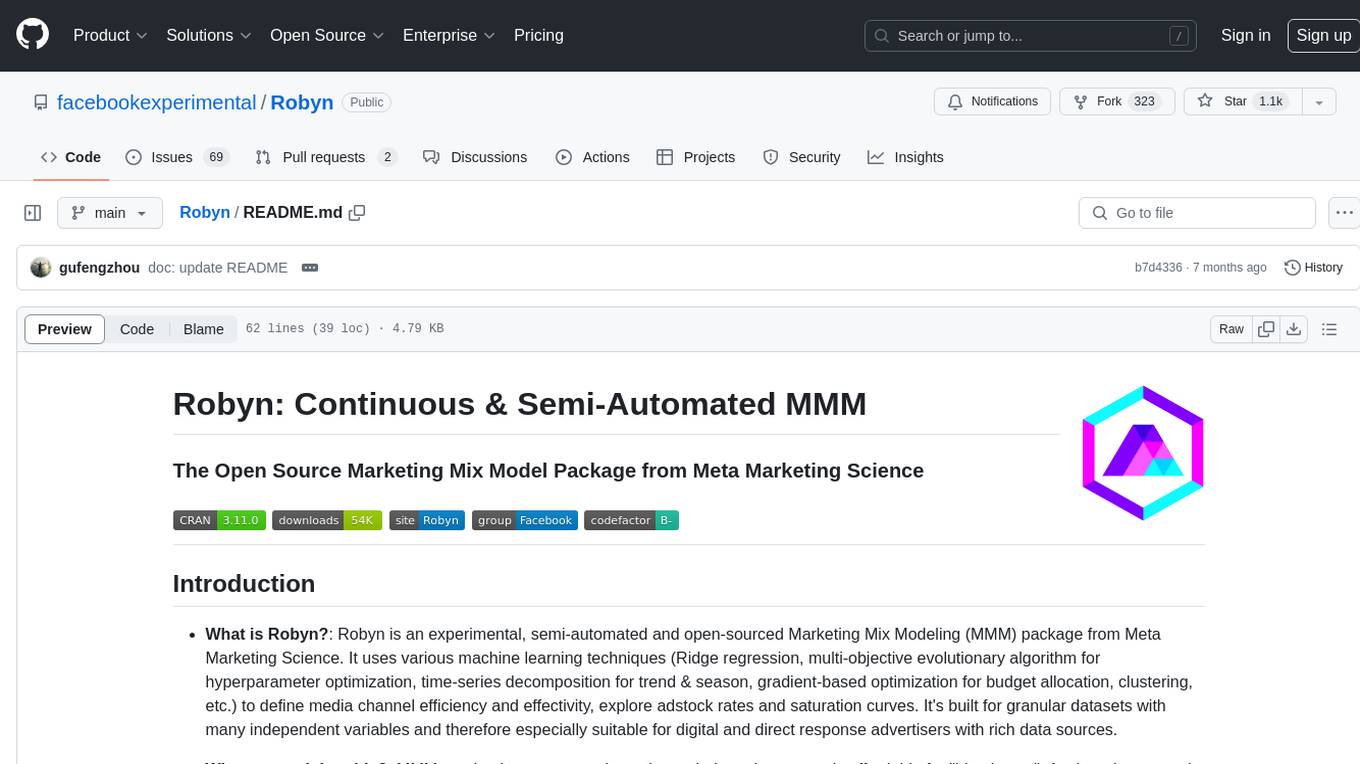
Robyn
Robyn is an experimental, semi-automated and open-sourced Marketing Mix Modeling (MMM) package from Meta Marketing Science. It uses various machine learning techniques to define media channel efficiency and effectivity, explore adstock rates and saturation curves. Built for granular datasets with many independent variables, especially suitable for digital and direct response advertisers with rich data sources. Aiming to democratize MMM, make it accessible for advertisers of all sizes, and contribute to the measurement landscape.
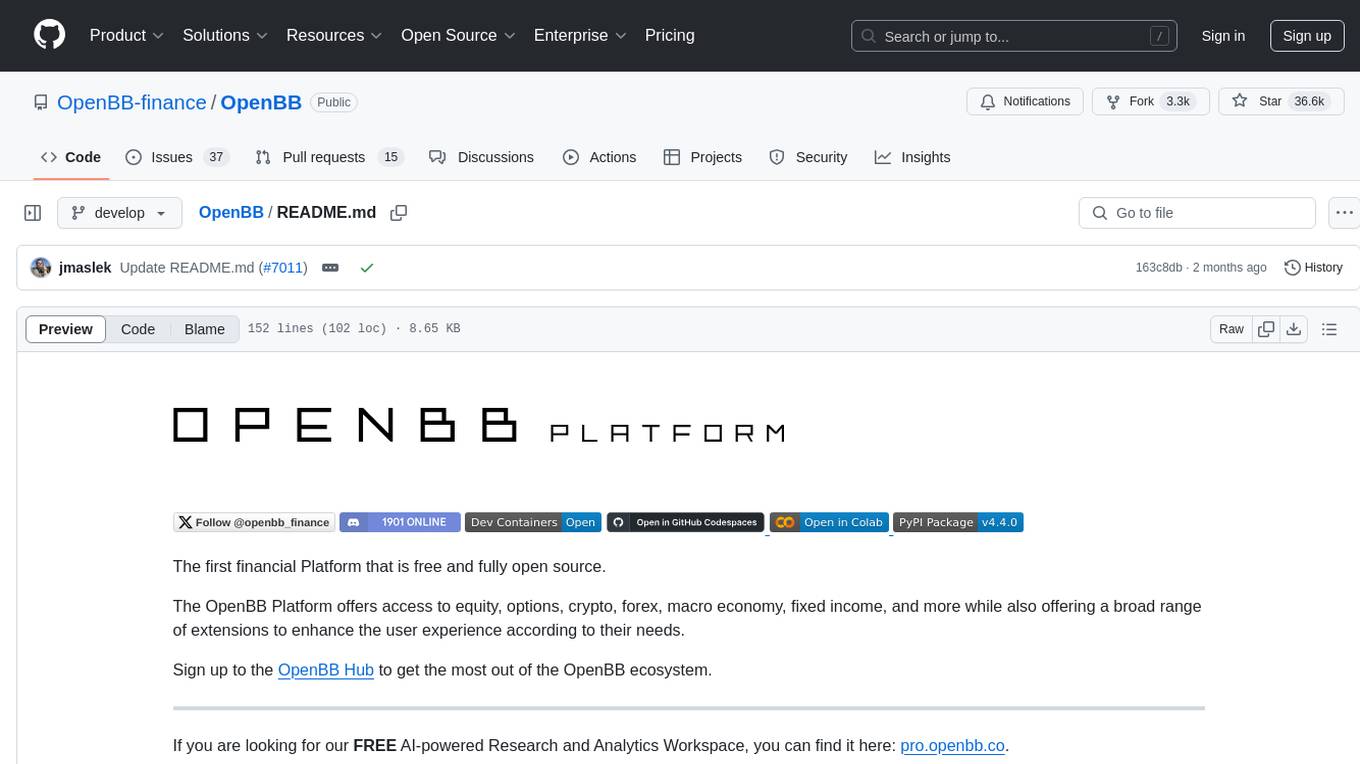
OpenBB
The OpenBB Platform is the first financial platform that is free and fully open source, offering access to equity, options, crypto, forex, macro economy, fixed income, and more. It provides a broad range of extensions to enhance the user experience according to their needs. Users can sign up to the OpenBB Hub to maximize the benefits of the OpenBB ecosystem. Additionally, the platform includes an AI-powered Research and Analytics Workspace for free. There is also an open source AI financial analyst agent available that can access all the data within OpenBB.
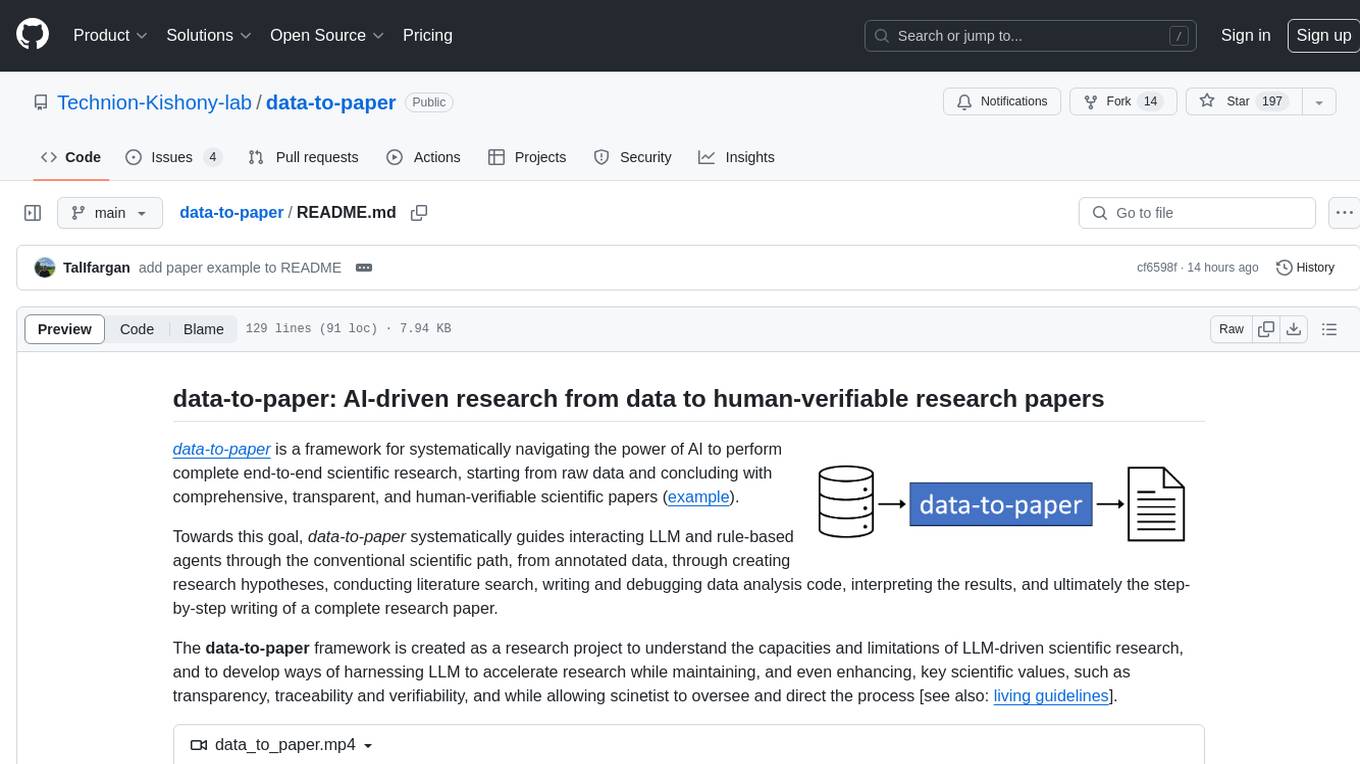
data-to-paper
Data-to-paper is an AI-driven framework designed to guide users through the process of conducting end-to-end scientific research, starting from raw data to the creation of comprehensive and human-verifiable research papers. The framework leverages a combination of LLM and rule-based agents to assist in tasks such as hypothesis generation, literature search, data analysis, result interpretation, and paper writing. It aims to accelerate research while maintaining key scientific values like transparency, traceability, and verifiability. The framework is field-agnostic, supports both open-goal and fixed-goal research, creates data-chained manuscripts, involves human-in-the-loop interaction, and allows for transparent replay of the research process.
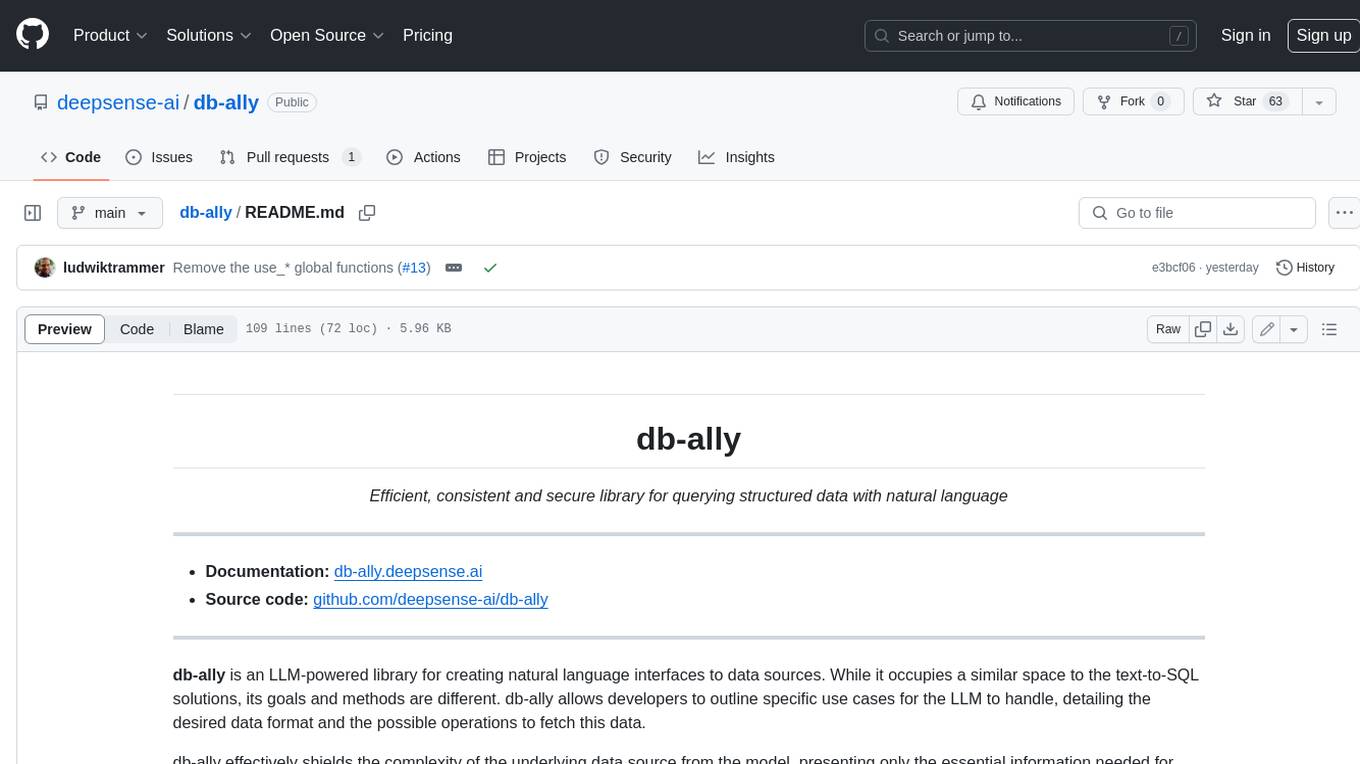
db-ally
db-ally is a library for creating natural language interfaces to data sources. It allows developers to outline specific use cases for a large language model (LLM) to handle, detailing the desired data format and the possible operations to fetch this data. db-ally effectively shields the complexity of the underlying data source from the model, presenting only the essential information needed for solving the specific use cases. Instead of generating arbitrary SQL, the model is asked to generate responses in a simplified query language.
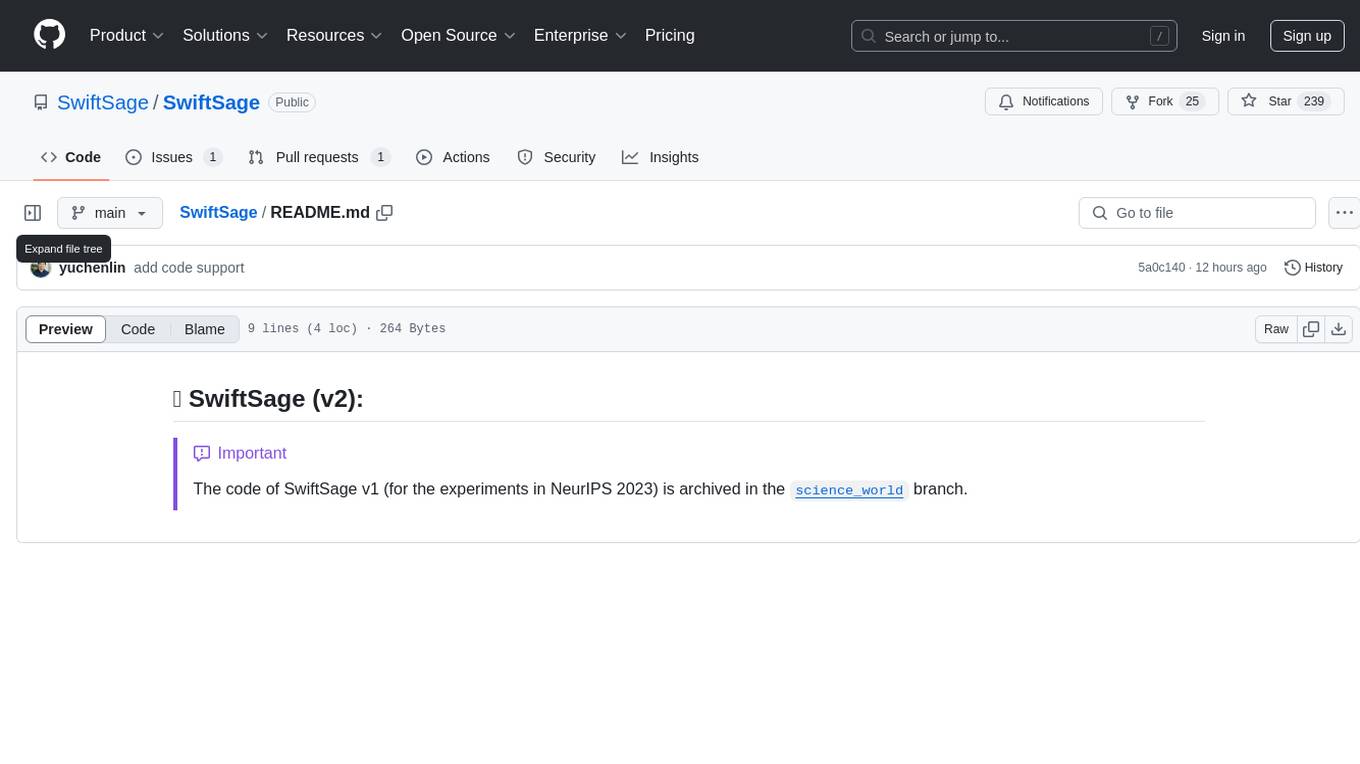
SwiftSage
SwiftSage is a tool designed for conducting experiments in the field of machine learning and artificial intelligence. It provides a platform for researchers and developers to implement and test various algorithms and models. The tool is particularly useful for exploring new ideas and conducting experiments in a controlled environment. SwiftSage aims to streamline the process of developing and testing machine learning models, making it easier for users to iterate on their ideas and achieve better results. With its user-friendly interface and powerful features, SwiftSage is a valuable tool for anyone working in the field of AI and ML.
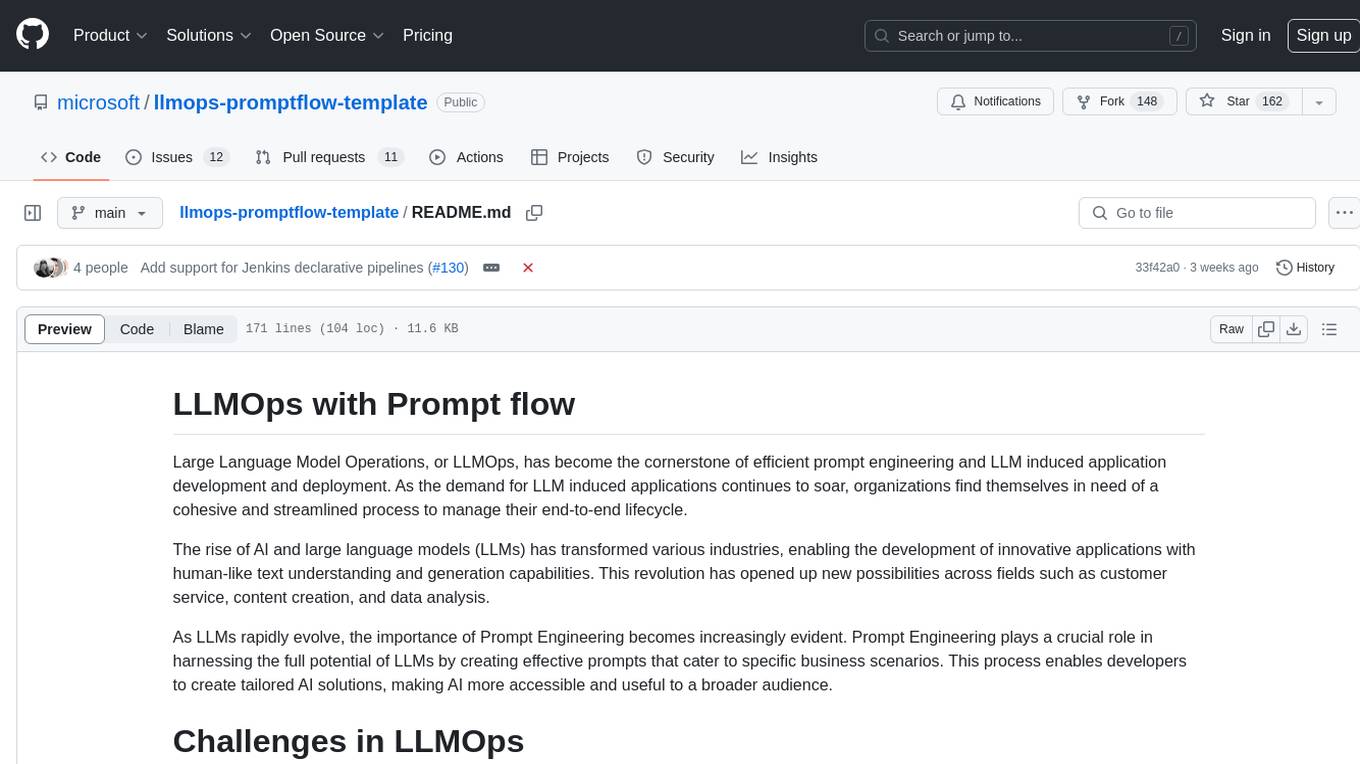
llmops-promptflow-template
LLMOps with Prompt flow is a template and guidance for building LLM-infused apps using Prompt flow. It provides centralized code hosting, lifecycle management, variant and hyperparameter experimentation, A/B deployment, many-to-many dataset/flow relationships, multiple deployment targets, comprehensive reporting, BYOF capabilities, configuration-based development, local prompt experimentation and evaluation, endpoint testing, and optional Human-in-loop validation. The tool is customizable to suit various application needs.
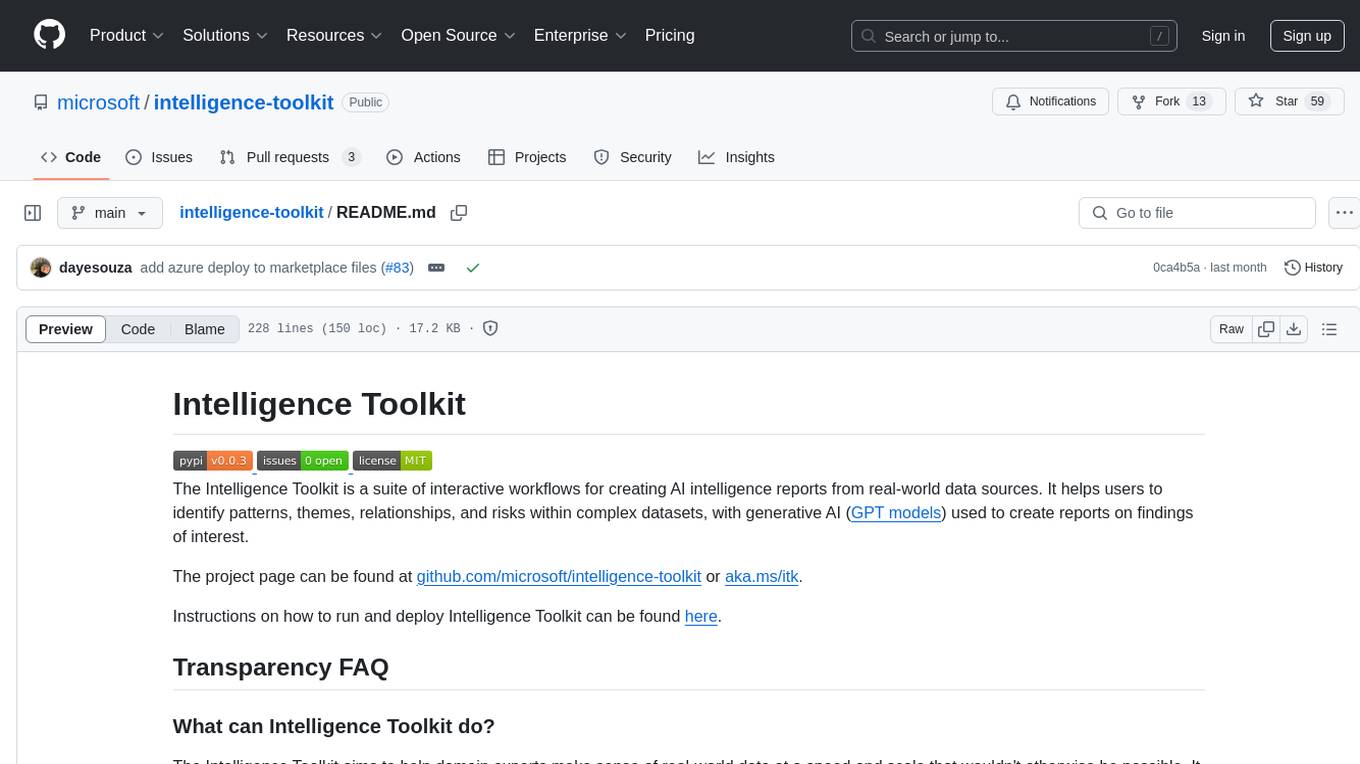
intelligence-toolkit
The Intelligence Toolkit is a suite of interactive workflows designed to help domain experts make sense of real-world data by identifying patterns, themes, relationships, and risks within complex datasets. It utilizes generative AI (GPT models) to create reports on findings of interest. The toolkit supports analysis of case, entity, and text data, providing various interactive workflows for different intelligence tasks. Users are expected to evaluate the quality of data insights and AI interpretations before taking action. The system is designed for moderate-sized datasets and responsible use of personal case data. It uses the GPT-4 model from OpenAI or Azure OpenAI APIs for generating reports and insights.
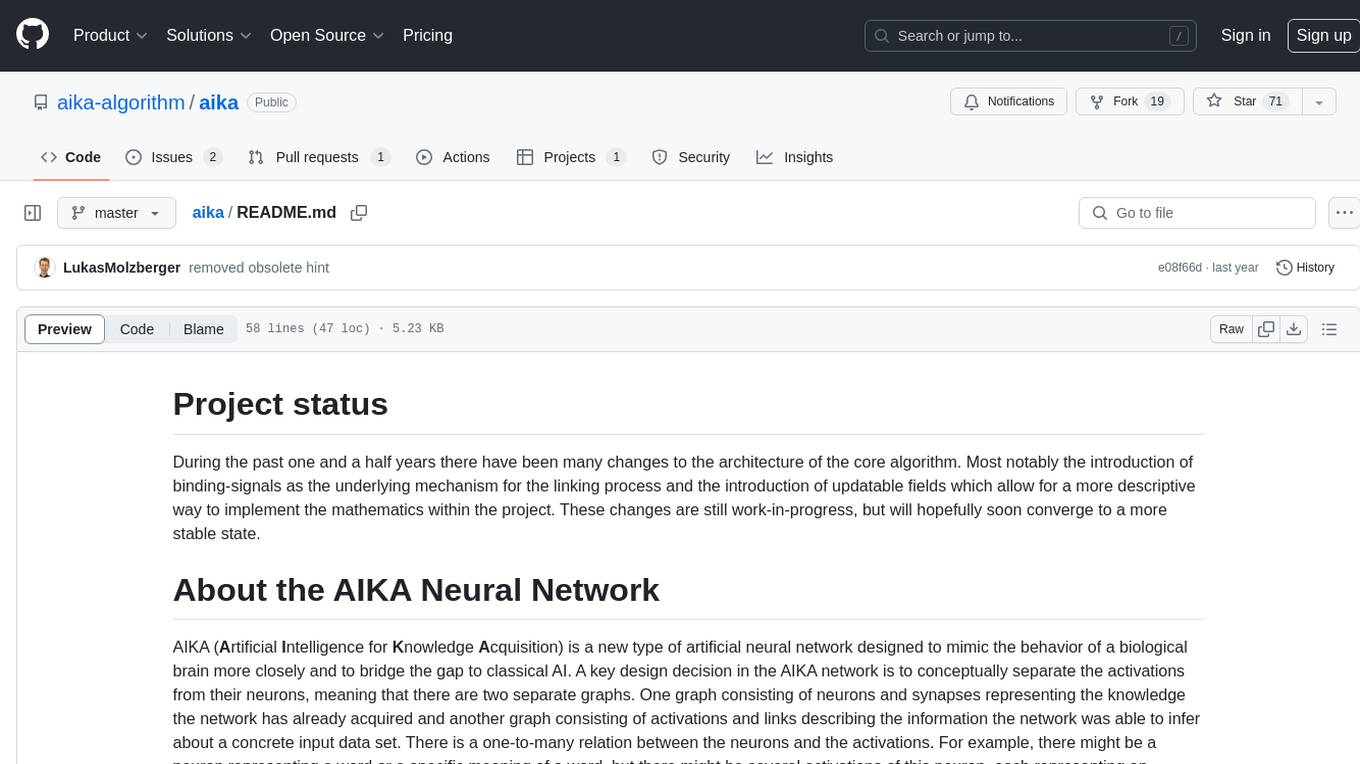
aika
AIKA (Artificial Intelligence for Knowledge Acquisition) is a new type of artificial neural network designed to mimic the behavior of a biological brain more closely and bridge the gap to classical AI. The network conceptually separates activations from neurons, creating two separate graphs to represent acquired knowledge and inferred information. It uses different types of neurons and synapses to propagate activation values, binding signals, causal relations, and training gradients. The network structure allows for flexible topology and supports the gradual population of neurons and synapses during training.
For similar tasks

DNAnalyzer
DNAnalyzer is a nonprofit organization dedicated to revolutionizing DNA analysis through AI-powered tools. It aims to democratize access to DNA analysis for a deeper understanding of human health and disease. The tool provides innovative AI-powered analysis and interpretive tools to empower geneticists, physicians, and researchers to gain deep insights into DNA sequences, revolutionizing how we understand human health and disease.
For similar jobs
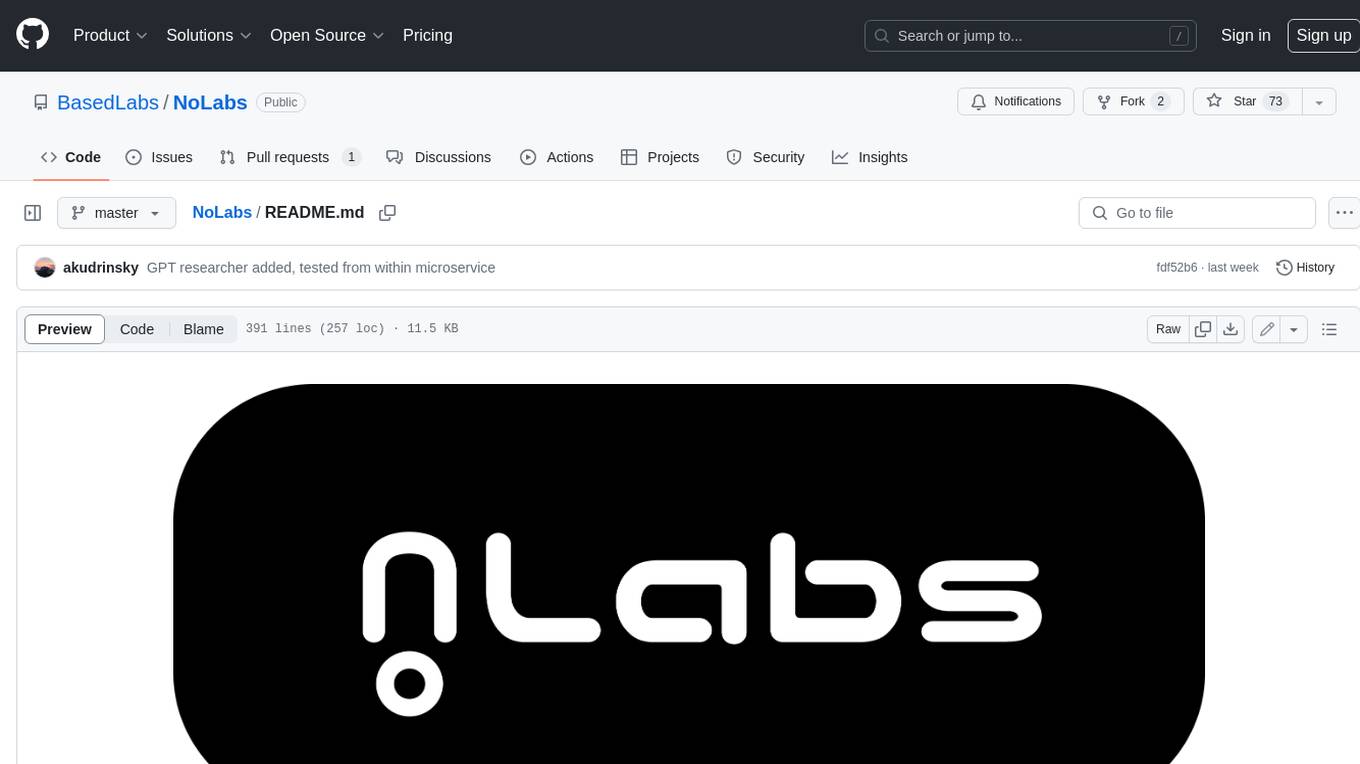
NoLabs
NoLabs is an open-source biolab that provides easy access to state-of-the-art models for bio research. It supports various tasks, including drug discovery, protein analysis, and small molecule design. NoLabs aims to accelerate bio research by making inference models accessible to everyone.
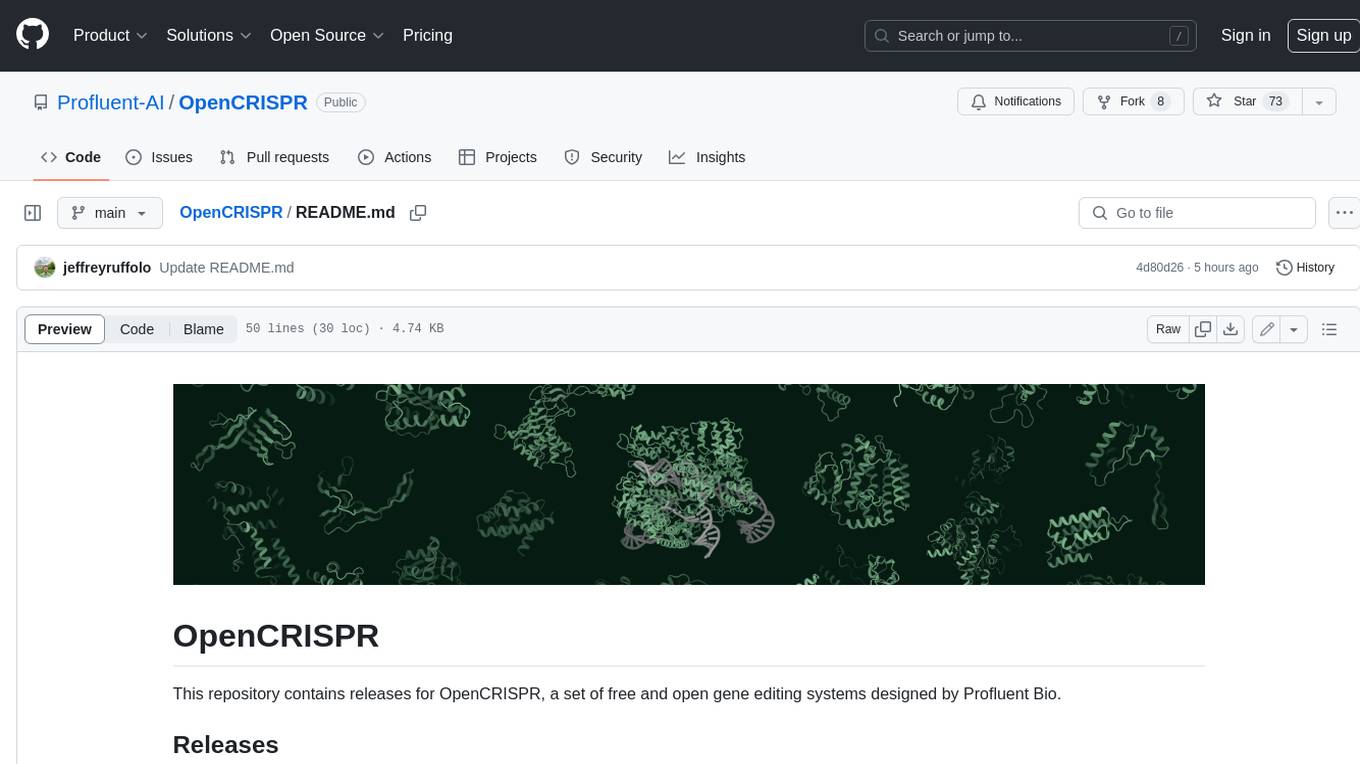
OpenCRISPR
OpenCRISPR is a set of free and open gene editing systems designed by Profluent Bio. The OpenCRISPR-1 protein maintains the prototypical architecture of a Type II Cas9 nuclease but is hundreds of mutations away from SpCas9 or any other known natural CRISPR-associated protein. You can view OpenCRISPR-1 as a drop-in replacement for many protocols that need a cas9-like protein with an NGG PAM and you can even use it with canonical SpCas9 gRNAs. OpenCRISPR-1 can be fused in a deactivated or nickase format for next generation gene editing techniques like base, prime, or epigenome editing.
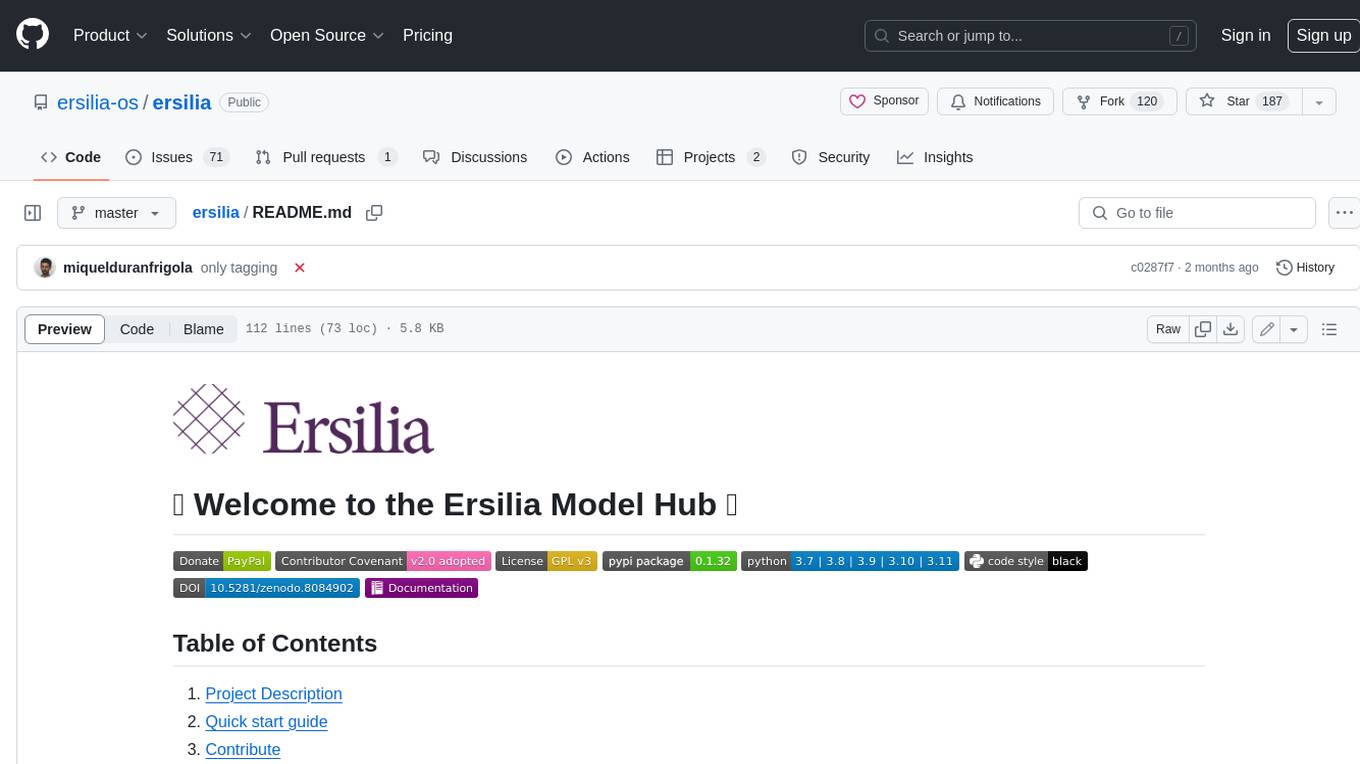
ersilia
The Ersilia Model Hub is a unified platform of pre-trained AI/ML models dedicated to infectious and neglected disease research. It offers an open-source, low-code solution that provides seamless access to AI/ML models for drug discovery. Models housed in the hub come from two sources: published models from literature (with due third-party acknowledgment) and custom models developed by the Ersilia team or contributors.
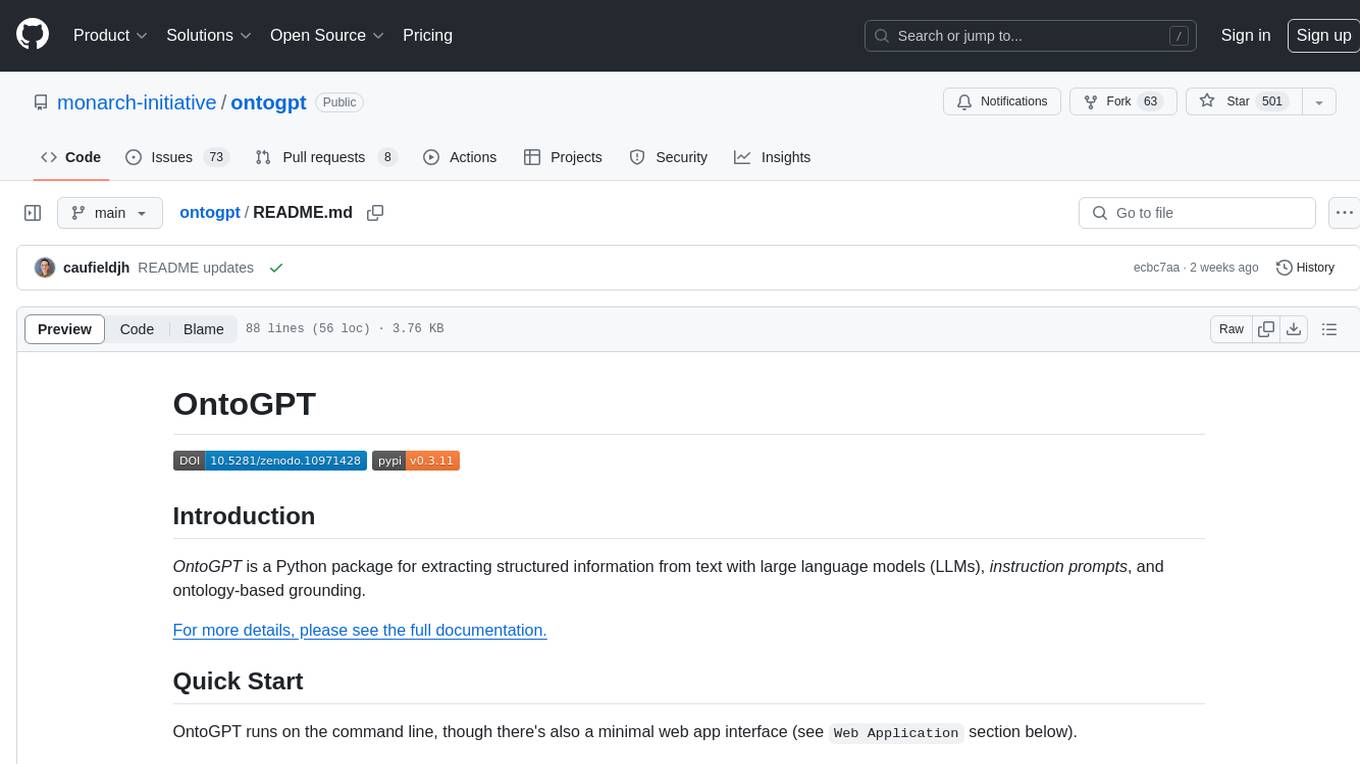
ontogpt
OntoGPT is a Python package for extracting structured information from text using large language models, instruction prompts, and ontology-based grounding. It provides a command line interface and a minimal web app for easy usage. The tool has been evaluated on test data and is used in related projects like TALISMAN for gene set analysis. OntoGPT enables users to extract information from text by specifying relevant terms and provides the extracted objects as output.
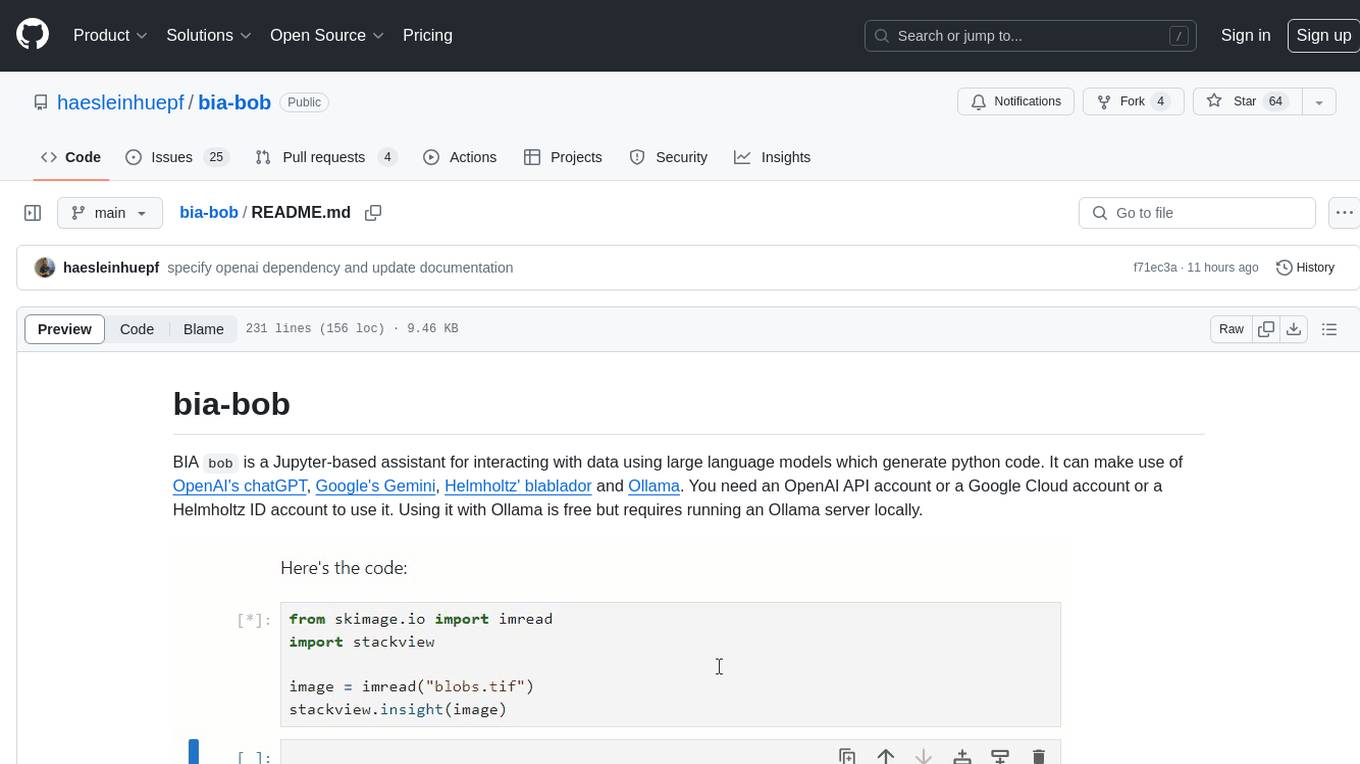
bia-bob
BIA `bob` is a Jupyter-based assistant for interacting with data using large language models to generate Python code. It can utilize OpenAI's chatGPT, Google's Gemini, Helmholtz' blablador, and Ollama. Users need respective accounts to access these services. Bob can assist in code generation, bug fixing, code documentation, GPU-acceleration, and offers a no-code custom Jupyter Kernel. It provides example notebooks for various tasks like bio-image analysis, model selection, and bug fixing. Installation is recommended via conda/mamba environment. Custom endpoints like blablador and ollama can be used. Google Cloud AI API integration is also supported. The tool is extensible for Python libraries to enhance Bob's functionality.
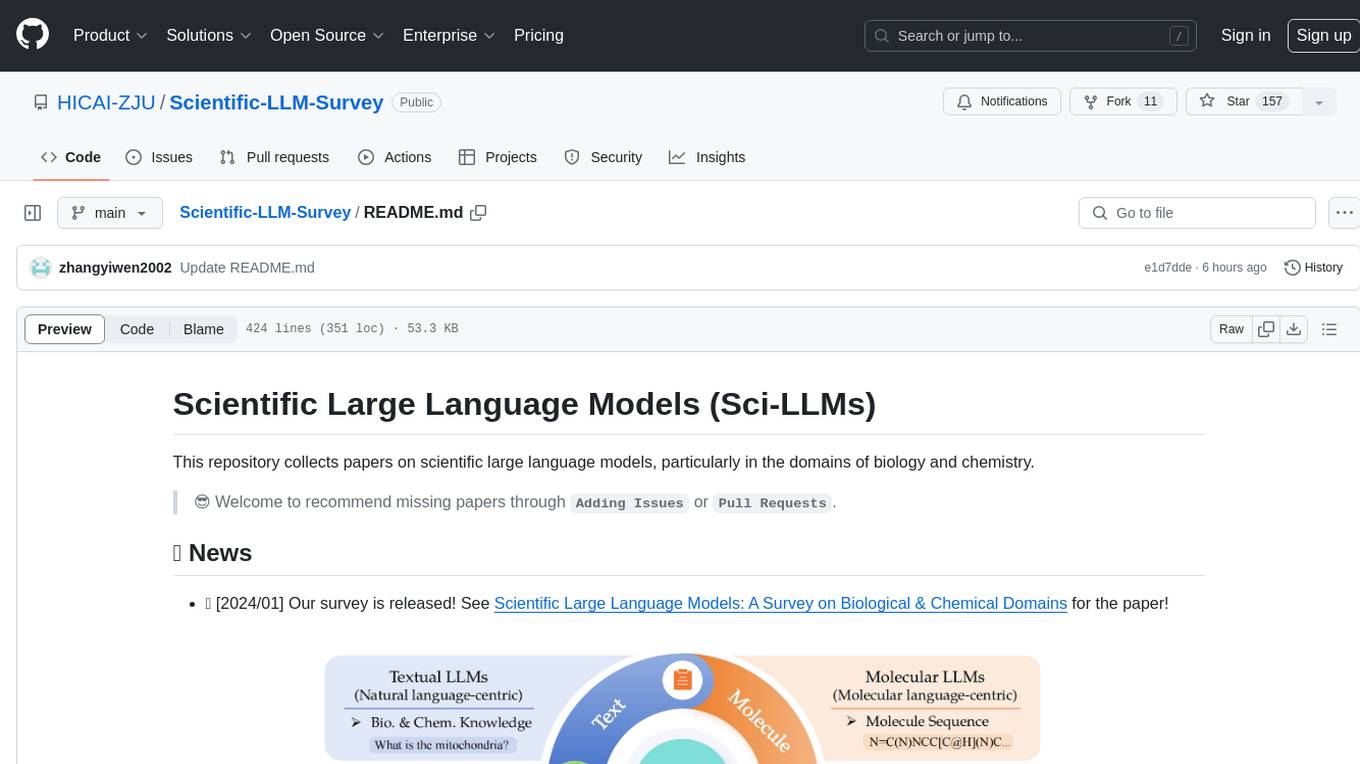
Scientific-LLM-Survey
Scientific Large Language Models (Sci-LLMs) is a repository that collects papers on scientific large language models, focusing on biology and chemistry domains. It includes textual, molecular, protein, and genomic languages, as well as multimodal language. The repository covers various large language models for tasks such as molecule property prediction, interaction prediction, protein sequence representation, protein sequence generation/design, DNA-protein interaction prediction, and RNA prediction. It also provides datasets and benchmarks for evaluating these models. The repository aims to facilitate research and development in the field of scientific language modeling.
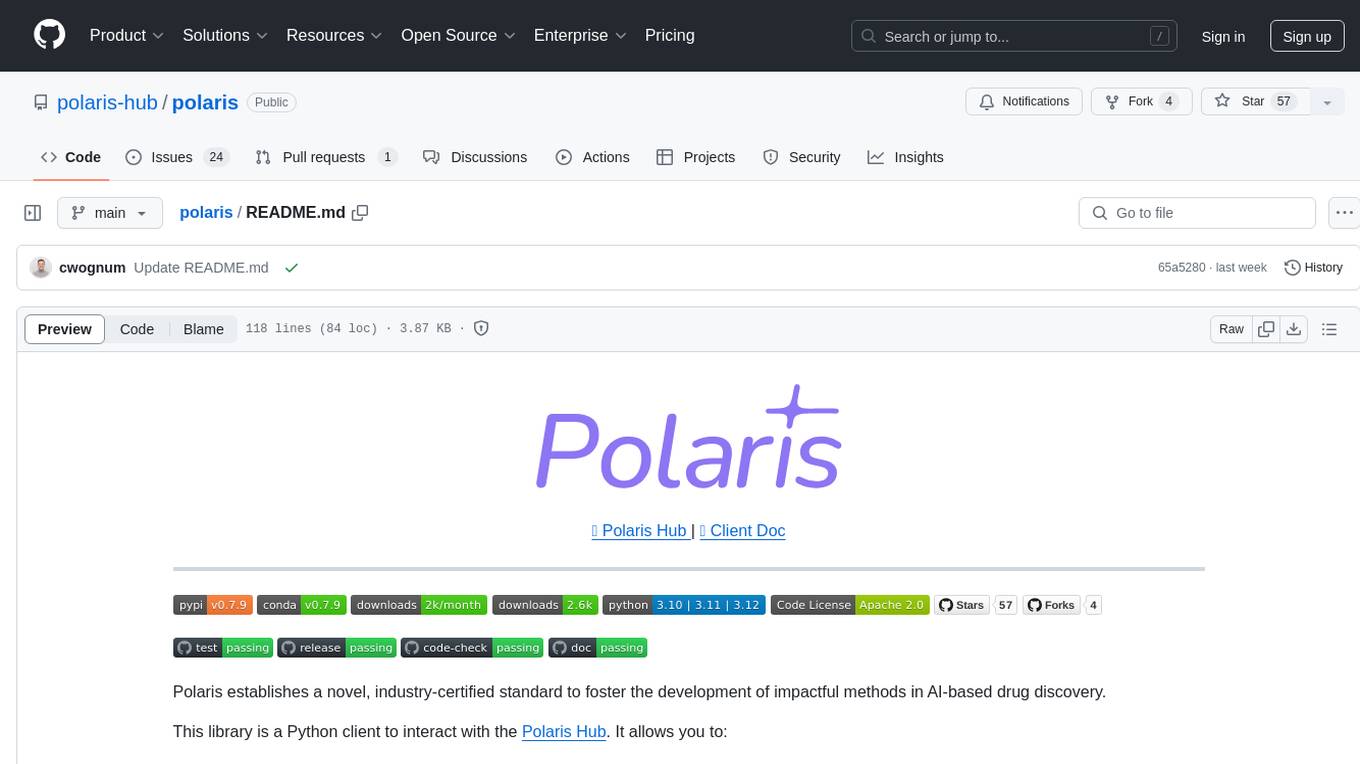
polaris
Polaris establishes a novel, industry‑certified standard to foster the development of impactful methods in AI-based drug discovery. This library is a Python client to interact with the Polaris Hub. It allows you to download Polaris datasets and benchmarks, evaluate a custom method against a Polaris benchmark, and create and upload new datasets and benchmarks.
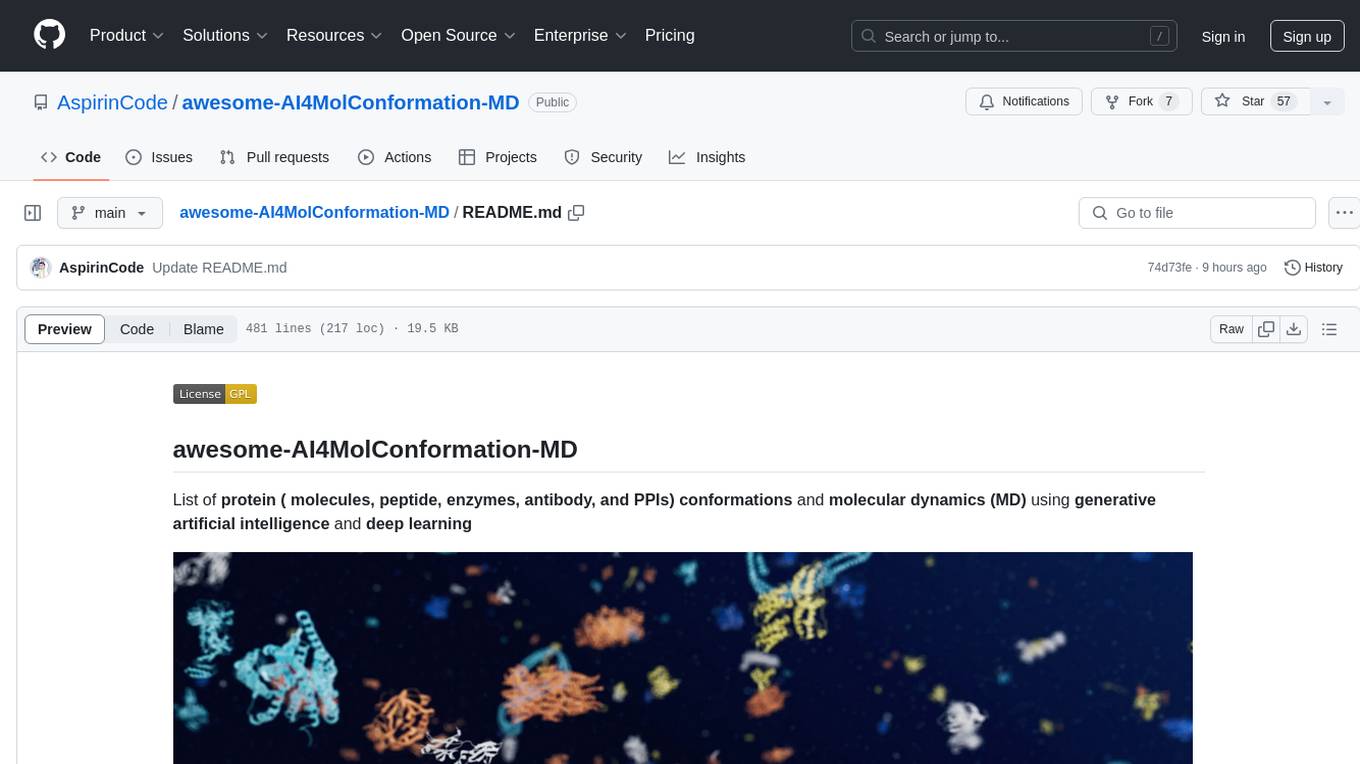
awesome-AI4MolConformation-MD
The 'awesome-AI4MolConformation-MD' repository focuses on protein conformations and molecular dynamics using generative artificial intelligence and deep learning. It provides resources, reviews, datasets, packages, and tools related to AI-driven molecular dynamics simulations. The repository covers a wide range of topics such as neural networks potentials, force fields, AI engines/frameworks, trajectory analysis, visualization tools, and various AI-based models for protein conformational sampling. It serves as a comprehensive guide for researchers and practitioners interested in leveraging AI for studying molecular structures and dynamics.





